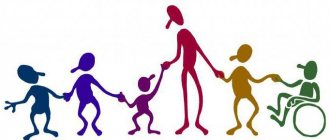A socio-psychological characteristic is a set of certain socio-psychological phenomena that characterize the properties, characteristics and qualities of an individual, various social groups, groups, etc., caused either by factors of the social environment, its influence, or by factors of a psychological nature.
The formation and development of an individual, social groups, and collectives are influenced by relationships within groups and individuals with each other, activities, political situation, ideology, cultural heritage, religion, upbringing and much more.
What is a socio-psychological characteristic?
What is a socio-psychological characteristic? This is a set of social and psychological phenomena that explain the qualities, characteristics, properties of an individual, team, family, society, etc. Personal characteristics are determined by the psychological qualities of each component or social factors that influence it.
The characteristics of a group, family, team are determined by the psyche of each member, their relationships, common activities, religion, culture, upbringing, political situation and other factors.
Classification
Social and psychological phenomena of social psychology and their manifestations depend on many things. From the communities, small and large groups in which they arise.
Also on their type. Communities can be both organized and unorganized. The phenomena that arise in them are called mass-like (this will be discussed below), and the behavior is called spontaneous.
The class of psychological phenomena also matters. Phenomena can be rationally meaningful (opinion, belief, values), emotionally ordered (mood, social feelings), functioning in certain conditions (for example, in extreme or conflict situations). And of course, they can be both conscious and unconscious.
Socio-psychological characteristics of personality
A personality is a person who has activity and consciousness that help him chart his path through life. Personality is formed as one lives. It is determined by the social factors in which it develops, the activities it produces, as well as the ways of consumption and acquisition of material goods. Socio-psychological characteristics are formed as a result of social interaction with other people, in which everyone influences each other.
The socio-psychological characteristics of an individual are also influenced by her anatomical and physiological capabilities, which shape her behavior and psyche. In addition, a person occupies a certain status in society, which influences the formation of specific skills and qualities in him.
Personal characteristics consist of characteristics, interests, views, inclinations and qualities of his psyche. What becomes significant is that a person does not have absolutely stable characteristics. In the process of life they change, transform or strengthen. It depends on the circumstances in which a person periodically finds himself, the activities he carries out, the attitude he displays towards the situation, and the position he occupies in a given situation.
A person is an individual because many of his characteristics are not innate. Only types of higher nervous activity can be genetically determined, but even they are subject to correction during life. No two people are the same, since different psychological characteristics develop from the same background.
The main thing in the formation of socio-psychological characteristics remains the life path, which is based on the worldview that guides the individual. Depending on the path of life, certain qualities and characteristics, interests and inclinations develop. All this begins with the family and social upbringing through which the individual goes.
Socio-psychological characteristics consider the following concepts in personality:
- Interests – what objects does a person pay attention to? They influence the focus and choice of life path. The more stable they are, the more focused the individual is and the more successful he is.
- Inclination is the direction of action in a certain type of activity.
- A need is a physiological need that provokes temporary interest, after satisfying which the need passes.
- Ability is a mental skill that ensures the successful performance of an activity.
- Giftedness is a set of inclinations on the basis of which certain abilities can be developed.
- Temperament is a combination of emotional excitability, manifestation of emotions and mobility.
- Character is a set of qualities and mental traits that influence the decisions and actions of an individual.
Analysis Options
The socio-psychological parameters of personality analysis are as follows:
- Maturity . The highest level of maturity is the presence of certain life attitudes and views. A mature person is guided in his actions by an individual value system. He occupies a respected position in society and is an object to be emulated; he does not give up his views even under the threat of violence. Such a person can contribute to the development of other members of society who take their example from him. An immature personality is characterized by the absence of a clear value system and a low level of social responsibility.
- Adaptation .
This is the degree of adaptation of a person to the life of society. With conflict adaptation, non-acceptance of social norms occurs, which leads to psychological tension and difficulties with self-realization. With average adaptation, a person fully gets used to the surrounding reality and functions more or less successfully in society. With a high level of adaptation, the individual not only adapts to the surrounding reality, but also successfully develops in the proposed conditions. - Adequacy . This is the acceptance and assimilation by a person of the norms and principles existing in society. An individual does not simply externally adjust his behavior to generally accepted models, but internally transforms himself in the process of socialization. People who are adequate from a social point of view are distinguished by a high level of morality and ethics.
- Identity . This is the result of a person's self-identification. Having realized his “I”, an individual can compare the demands put forward by society and the opportunities provided with his abilities and desires. As a result, a mechanism for regulating behavior in society is developed, taking into account ideas about oneself.
Social characteristics of personality
Personality is a social being. A person is not born as a person, but becomes one in the environment in which he grows and develops. As a person interacts with society, he acquires certain social characteristics. He plays out social roles and tries to adapt to society, which happens more or less successfully.
There are 2 social roles:
- Conventional - roles that are given by society, depending on social status: father, husband, boss, etc.
- Interpersonal – roles that depend on the personal characteristics of the individual.
A person's status is determined by the rights and responsibilities he has. In each group, a person occupies a certain role, where, first of all, he builds certain business or personal relationships. This is where his characteristics and qualities are formed, which then manifest themselves and characterize the person.
E. Erikson's theory of psychosocial development
E. Erikson argued that a person develops throughout his life.
From birth to death, it goes through 8 stages, each of which is accompanied by a certain crisis :
- infancy (0-1 year),
- early childhood (1-3 years),
- childhood (3-6 years),
- school age (6-12 years),
- adolescence and youth (12-20 years),
- early maturity (20-25 years),
- middle age (25-65 years),
- late maturity (after 65 years).
Every crisis can end well or negatively .
If a person successfully overcomes it, then he moves on to the next stage of life with good prerequisites for further personal development.
If the crisis is not overcome, then the transition to the next level still occurs, but unresolved problems at the new level remain with the person.
Social and psychological characteristics of the group
A person does not live separately from others. Sooner or later, he classifies himself as a member of a certain group - an association in which more than two people are united by interests, common goals, activities, motives, tasks, etc. A group is a single organism that includes individuals with their own socio-psychological characteristics . This, in turn, forms the characteristics of the group with its socio-psychological orientation.
Small groups play an important role in the life of every individual. Small groups are families, teams, friends, school classes or college groups. All of them include on average up to 30 people who are united by a common cause and goals, interests and views. Here there is a greater impact on each individual.
A group is a cell to which an individual is attached. One of its characteristics is the commonality on which people unite. Cohesion is the second socio-psychological characteristic.
The composition of a group is the qualitative composition, that is, the characteristics of its members. Size is the number of group members (that is, a quantitative characteristic).
In a group, two factors become important:
- Communication – its culture, manners, language, etc.
- The relationships between its members are morals and ethics, rules and norms.
Uniting and achieving results
This is what collaboration means. Cohesion is a process during which a specific connection is formed between people, due to which they unite into a “single organism”. Everything, again, is done to achieve certain goals and results. Each of the group members is interested in this.
It is customary to distinguish levels of cohesion. And at the first stage, the development of emotional contacts usually occurs - the manifestation of sympathy and disposition of people towards each other, for example. The second level involves the process of convincing each person that his value system coincides with others. And the third is where the common goal is shared.
All this influences the formation of the so-called socio-psychological climate in the team, which contributes to maintaining a general mood, a decent level of performance and well-being.
Social and psychological characteristics of the team
A developed group becomes a team, in which stable norms of relationships have already been formed, and socially useful areas of activity are also noted. Each member has his own position, status, type of activity that he performs, tasks, etc. We can talk about the presence of a hierarchy within the team, where there are higher and lower substructures. If we talk about the socio-psychological characteristic, then it is no longer the collective that is formed, but the collective that is subordinate to it.
The characteristics of the team are:
- Public mood.
- Public opinion, attitudes, beliefs.
- Collective traditions, customs, habits.
- Public feelings.
- Requirements, authority and mutual assessments.
The team already has established rules and regulations. However, this does not mean that a person cannot express himself within this framework. Relationships between team members are established individually, but they rarely go beyond the established rules.
The main characteristics of the socio-psychological orientation of the team are:
- Discipline is the determination of the behavior of each member in order to organize a unified mechanism of action within the team.
- Awareness is the presence of all the information that allows everyone to pursue a common goal and set the necessary tasks.
- Organization is the flexibility of the team to external changes that influence the change in the course of events.
- Activity is the free expression of one’s activity by each individual.
- Cohesion is a unifying component of a psychological nature that allows a team to maintain its structure and be a single mechanism.
Concept and tasks
In modern psychology, the concept of “social group” is a collection of individuals who have similar features, perform the same type of activity, and perceive themselves as members of a community. The group has 3 main qualities:
- mandatory interaction between participants;
- unity of goals for which the group was created;
- all members have a characteristic unique to this community.
Social psychology of groups studies the process of group formation, its types, structure and influence on the individual. The task of the industry is to assess and forecast the development of the group, identify the characteristics of interaction, and the main criteria. Throughout life, a person simultaneously belongs to several groups and often moves from one to another. This is due to a change in activity or status: for example, a schoolchild becomes a student, a worker becomes a pensioner. In this regard, we can highlight the main task of social psychology of groups - classification according to certain criteria.
Social and psychological characteristics of the child
The characteristics of a child are determined by the types of activities in which he develops and grows. First of all, attention is drawn to the socio-psychological structure of the family, which can be complete or incomplete, prosperous or dysfunctional. Preschool children are determined by their interactions with the children around them, as well as by communication within the family. School-age children are characterized by academic success.
Other characteristics are the physiological components of the child: his health, congenital diseases, inclinations. The child’s communication skills and interaction with peers, teachers and caregivers are also assessed.
At an early age, a child learns about the world. How he imagines him at the end of this period largely depends on his upbringing and role models, which are his parents. Here he copies his parents.
In the primary school period, the child is exposed to voluntary behavior, which is often subordinated to selfish desires. It is important here that the child has an adequate understanding of the correctness of the actions being performed. The child is more susceptible to outside influence and is determined by social roles.
In adolescence, a desire for self-determination arises in the spheres of religion, profession, personality, spirituality, society, etc. In adolescence, a person begins to form his social status, which needs respect from others.
Types
In modern science, it is customary to distinguish the following social personality types from the point of view of value orientations inherent in individuals:
- Traditionalists . For them, law-abidingness, diligence, discipline and responsibility come first. Similar traits are observed against the background of a lack of desire for self-realization and independence.
- Idealists . They are the exact opposite of traditionalists. They strive to prove themselves and act in accordance with their own attitudes and principles. They do not recognize authorities and traditional views on issues.
- Frustrated type . These people do not feel involved in public life or in making important public decisions. They are characterized by low self-esteem, a constant state of depression and passivity.
- Realists .
Such individuals competently combine the desire for self-realization with an awareness of a sense of duty. They are able to rationally approach problems and objectively assess the proposed circumstances. - Hedonistic materialists. They are typical consumers who strive for immediate pleasures without thinking about the future. Their own desires always come first for them.
Personality types:
Social and psychological characteristics of the family
The main institution and unit of society is the family, which is characterized by the main socio-psychological feature - communication on 3 levels:
- Communication between spouses.
- Communication between parents and children.
- Communication between spouses and each other's parents and friends.
The family first begins in the form of marriage, then children are born, who eventually leave, leaving the “nest empty.” These are the stages of family development. And communication consists of closeness, sincerity, and the opportunity to discuss problems with other family members.
The family performs the following functions:
- Raising a new generation and passing on cultural experience to it.
- Preserving the health of each member, caring for others.
- Financial support and support for those who cannot or have not yet reached working age.
- Spiritual development of each member.
- Development of leisure, its enrichment.
- Determination of the social status of each member.
- Psychological protection and emotional support.









